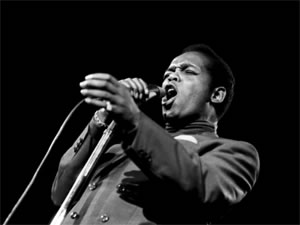(From the 2003 Monterey Bay Blues Festival program)

Of all the performers making a return engagement to the Monterey County Fairgrounds this year, Lou Rawls could take the prize for longevity. His first appearance at the Fairgrounds was 36 years ago. It was an important moment in music that many will never forget. It was June 1967, and the Monterey International Pop Festival was about to become the phenomenon of its time, launching the careers of rock legends Janis Joplin, Jimi Hendrix, the Who, and scores of others. Two years before anyone had even heard of Woodstock, Monterey Pop had already defined a generation.
Lou Rawls remembers.
“I think the atmosphere that surrounded Monterey was ‘Hey, this is something worthwhile, this is something great to be a part of.’” At Monterey Pop, he found himself amongst such famous talents as Simon and Garfunkel, and the Mamas and the Papas. But Rawls himself was far from an unknown. His hit song Dead End Street was still on the charts at the time and would give him his first Grammy later that year.
You’d have to go earlier than that to get a sense of the man’s prolific career. Lou Rawls made a sensational debut on the Dick Clark Show at the Hollywood bowl in 1959. He recorded and toured with Sam Cooke, and by 1963 he was making his own records while making his first appearance on the Downbeat jazz polls.
The music of Lou Rawls evolved out of gospel and R & B, developing into something he called “monologue” music—rap, if you will—where he’d tell nitty-gritty stories of life and love as the band played behind him. At times he’s described some of his material as “rock and soul.” But one way or another it got back to the blues. “The blues is the music that makes a universal language,” he said after that Friday night performance back in 1967, “The blues is the way of the future.” Little did he know then that his prediction would materialize years later in that exact location in1986 when the Monterey Bay Blues Festival made its debut.
With a long list of recording and performing accomplishments and still going strong after 40 years, one might be tempted to regard Lou Rawls as a pop culture survivor. But that kind of show-biz hype has a way of obscuring genuine talent. Make no mistake, this guy is the real deal. He’s recorded over 75 albums, and in that time he’s received three Grammys, one Platinum album, five Gold albums, and one Gold single.
Lou Rawls’ musical talents haven’t been limited to the recording studio either. In the Seventies, he hit the Broadway stage with his own one-man show, and in 1999 he was back on Broadway appearing in Smokey Joe’s Café. You can also add a long list of appearances in feature films and television, if you like. He’s even performed cartoon voice-overs in such animation hits as Rugrats, Hey Arnold, as well as the singing voice for Garfield. So maybe the pop culture handle applies. But Lou Rawls is no mere show-biz survivor who’s simply endured over time. He’s a music talent who’s achieved considerable success in a wide variety of venues.
From nightclubs to arenas, from recording studios to the stage and screen, Lou Rawls has stayed true to his voice—a voice that’s as distinctive and instantly recognizable as any in music. “People may not know what I’m doing,” he explains of his versatility, “but they know it’s me.”
In 40 years of performing, Lou Rawls has had plenty of moments. Like the one back in Monterey, 1967—a moment that altered the musical landscape for years to come. In the midst of all the radical changes taking place on the pop culture front, Lou Rawls got it right as he sagely observed, “The fads come and go but the blues remain.”
